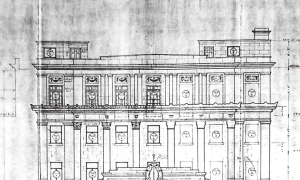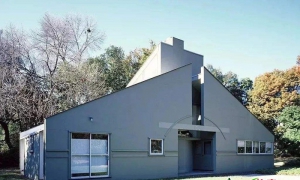|
建筑基本上是某种东西的容器。我希望人家更喜欢的不是茶杯,而是杯里的茶。—— 谷口吉生 Architecture is basically a container of something. I hope they will enjoy not so much the teacup, but the tea. —Yoshio Taniguchi D.T. Suzuki Museum 鈴木大拙館( 2011) Photo © Sampford Cathie 谷口吉生(Yoshio Taniguchi),日本当代建筑师,出生于1937年。他的父亲谷口吉郎(1904-1979)也是日本一位知名的建筑师,谷口吉生在大学期间并未受父亲影响主修建筑,反而是在庆应义塾大学主修机械工程专业。1960年毕业后,经常参与父亲与建筑师朋友的聚会讨论,渐渐对建筑产生兴趣,于是出国到哈佛大学念设计研究所。 Yoshio Taniguchi, a contemporary Japanese architect, was born in 1937. His father, Yoshiro Taniguchi (1904-1979), was also a well-known architect in Japan. Taniguchi did not major in architecture at university, but majored in mechanical engineering at Keio University. After graduation in 1960, he often participated in the discussions between his father and his architect friends. Gradually he became interested in architecture, so he went abroad to study design and research at Harvard University. D.T. Suzuki Museum 鈴木大拙館(2011) Photo © Sampford Cathie 谷口吉生曾短暂地为德国建筑师Walter Gropius工作,Walter Gropius后来对他产生了重要影响。在1964~1972年期间,他曾在现代主义建筑师丹下健三工作室工作过。1975年他成立了自己的建筑事务所,之后也曾与知名的野口勇、Peter Walker和Genichiro Inokuma合作过。 Taniguchi briefly worked for the German architect Walter Gropius, who later became an important influence on him. Between 1964 and 1972, he worked for modernist architect Kenzo Tashita's studio. He set up his own architecture office in 1975 and has since worked with such notable names as Isamu Noguchi, Peter Walker and Genichiro Inokuma. Kyoto National Museum 法隆寺博物馆(1999) Photo © Shen Photography 谷口吉生的建筑作品带有很强烈的正方型切割风格,常用大片玻璃或是薄形的结构,造型相当简洁,其中最有名的几乎都为日本博物馆或美术馆,包括京都国立博物馆新馆、纽约现代美术馆新馆、丰田市美术馆等。 Taniguchi's architectural works have a very strong square cutting style, often large glass or thin structure, the shape is quite simple, the most famous of which are almost all Japanese museums or art galleries, including the new National Museum of Kyoto, the new Museum of Modern Art in New York, the Toyota City Museum of Art and so on. Kyoto National Museum 京都国立博物馆 (2014) 当人们面对东方式的创造力时,往往没有采取一种冷静、理性、好奇的观点,而是倾向于把他们所看到的美学效果归因于某种神秘的精神力量——不管他们称之为禅、道、阴或阳——它们存在于东方文化中。在参观谷口吉生设计的建筑时,人们会强烈地诉诸于这种神秘的敬畏之心,因为他的作品有一种崇高感,暗示着一种隐藏的深度。 When confronted with Oriental creativity, people often do not take a cool, rational, curious view, but tend to attribute the aesthetic effects they see to some mystical spiritual force -- whether they call it Zen, Tao, Yin or Yang -- that exists in Eastern culture. This mystical awe is particularly strongly appealed to when visiting buildings designed by Yoshio Taniguchi. His work has a sense of subtlety, suggesting a hidden depth. Museum of Modern Art 纽约现代艺术博物馆 (2004) Photo © Timothy Hursley Yoshiro and Yoshio Taniguchi Museum of Architecture
| 
 走进中山纪念堂,了解一代大师吕彦直
我去过中山纪念堂很多次,大多是去看公益演出。有时路过,也会被它的外观吸引,不自
走进中山纪念堂,了解一代大师吕彦直
我去过中山纪念堂很多次,大多是去看公益演出。有时路过,也会被它的外观吸引,不自
 业师和雇主眼中的吕彦直—— 一份 1928 年
编者按:
2024年是吕彦直先生(1894年7月28日-1929年3月18日)诞辰130周年。他是中
业师和雇主眼中的吕彦直—— 一份 1928 年
编者按:
2024年是吕彦直先生(1894年7月28日-1929年3月18日)诞辰130周年。他是中
 罗伯特·文丘里:后现代主义建筑的先驱与影
文丘里的生平简介
后现代主义建筑革命的领军人物罗伯特·文丘里,于2018年9月18日在家
罗伯特·文丘里:后现代主义建筑的先驱与影
文丘里的生平简介
后现代主义建筑革命的领军人物罗伯特·文丘里,于2018年9月18日在家
 后现代主义的人文设计师:评罗伯特·文丘里
罗伯特·文丘里的后现代主义建筑理论思想对国际建筑设计行业具有极其深远的影响。
后现代主义的人文设计师:评罗伯特·文丘里
罗伯特·文丘里的后现代主义建筑理论思想对国际建筑设计行业具有极其深远的影响。
 后现代主义建筑的奠基人——罗伯特•文丘里
罗伯特·文丘里是世界著名的建筑师,1925年出生于美国宾夕法尼亚州费城,在普林斯顿大
后现代主义建筑的奠基人——罗伯特•文丘里
罗伯特·文丘里是世界著名的建筑师,1925年出生于美国宾夕法尼亚州费城,在普林斯顿大
 走进中山纪念堂,了解一代大师吕彦直
我去过中山纪念堂很多次,大多是去看公益演出。有时路过,也会被它的外观吸引,不自
走进中山纪念堂,了解一代大师吕彦直
我去过中山纪念堂很多次,大多是去看公益演出。有时路过,也会被它的外观吸引,不自
 业师和雇主眼中的吕彦直—— 一份 1928 年
编者按:
2024年是吕彦直先生(1894年7月28日-1929年3月18日)诞辰130周年。他是中
业师和雇主眼中的吕彦直—— 一份 1928 年
编者按:
2024年是吕彦直先生(1894年7月28日-1929年3月18日)诞辰130周年。他是中
 罗伯特·文丘里:后现代主义建筑的先驱与影
文丘里的生平简介
后现代主义建筑革命的领军人物罗伯特·文丘里,于2018年9月18日在家
罗伯特·文丘里:后现代主义建筑的先驱与影
文丘里的生平简介
后现代主义建筑革命的领军人物罗伯特·文丘里,于2018年9月18日在家